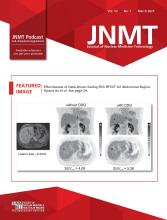Abstract
Objective: Chemotherapy followed by prophylactic cranial irradiation (PCI) is associated with increased survival in patients with small cell lung cancer (SCLC) but is associated with fatigue and cognitive impairment. This retrospective study evaluated regional differences in fluorodeoxyglucose (18F-FDG) uptake of the brain before and after PCI. The null hypothesis was that direct toxic effects on the brain from PCI and chemotherapy are symmetric, thus asymmetric deviations may reflect functional changes due to therapy. Materials and Methods: Electronic medical records from 2013-2016 were reviewed for patients with SCLC, MRI of brain negative for metastasis, and 18F-FDG-positron emission tomography/computed tomography (PET/CT) scans pre- and post PCI. As standard of care, patients received first-line chemotherapy or chemoradiation to the thorax followed by PCI. The 18F-FDGPET/CT scans closest in temporal proximity before and after PCI were selected. Sixteen patients met these initial criteria. Commercially available PET software (MIM) was utilized to register and subtract the PET scans pre-and post PCI to obtain difference maps. Occipital and cerebellar regions were excluded from the final statistical analysis given known high variability and misregistration. The Chi-square test was used to analyze the data. Results: Two patients had 18F-FDG uptake differences only in occipital and cerebellar regions. The software registration failed on one patient’s scans. Therefore, thirteen patients were included in the final analysis. Nine of thirteen patients demonstrated significant unilateral changes in only one region of the brain, and three of thirteen showed significant changes unilaterally in two regions. The Chi-square test revealed a significant unilateral regional difference on the patient level (X2 = 6.24, P = 0.025). The most commonly affected brain region was the frontal lobe. Conclusion: Significantly more patients had unilateral rather than bilateral regional differences (both increases and decreases) in 18F-FDG uptake in the brain pre-and post PCI. This suggests that differences in unilateral distribution are related to functional changes, since direct toxicity alone from PCI and chemotherapy would be symmetric. The frontal region was the most commonly affected, suggesting a potential contributing etiology for cognitive impairment and decreased executive function after therapy.







